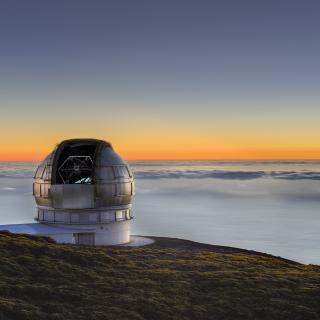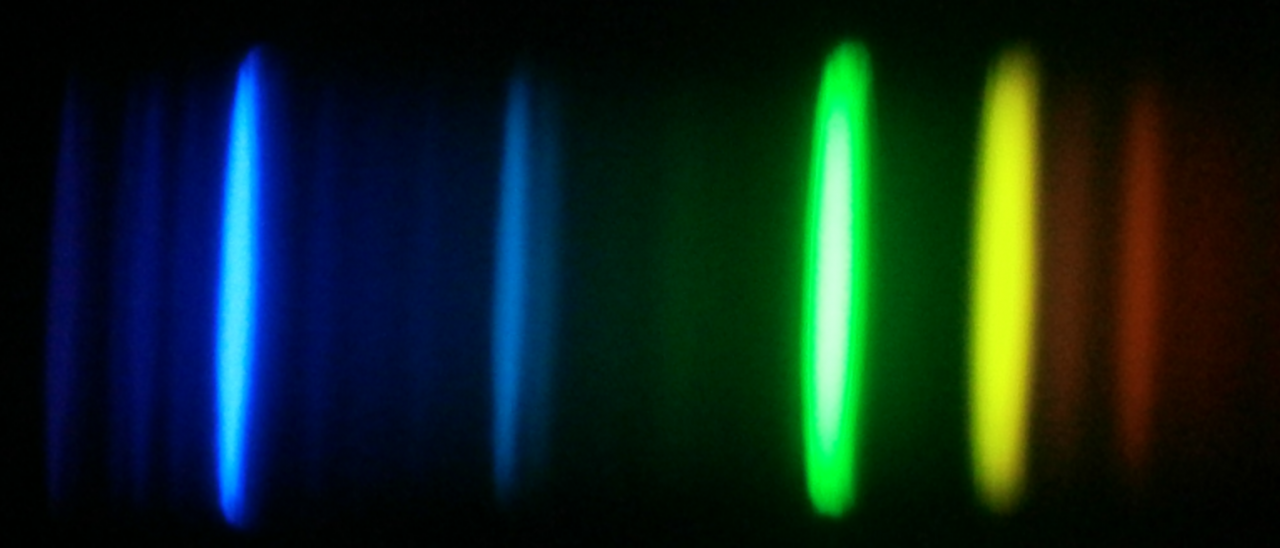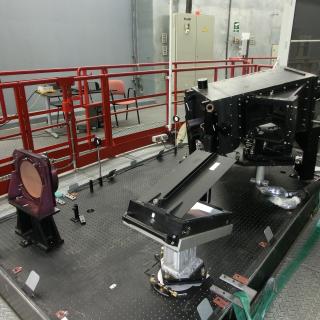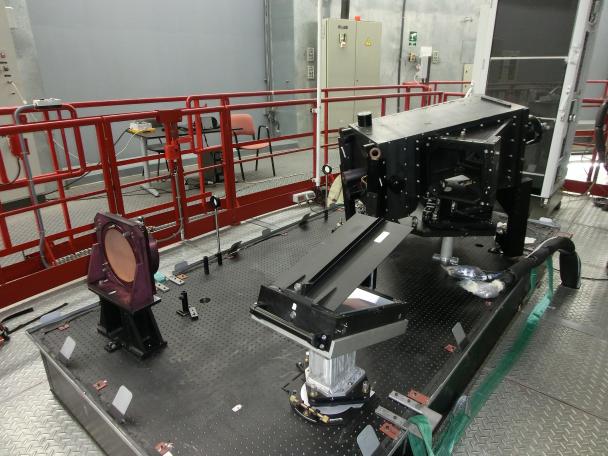Grants related:
General
Stellar spectroscopy allows us to determine the properties and chemical compositions of stars. From this information for stars of different ages in the Milky Way, it is possible to reconstruct the chemical evolution of the Galaxy, as well as the origin of the elements heavier than boron, created mainly in stellar interiors. It is also possible to study stellar formation, and the formation of the Galaxy, from the signature of the Galactic potential on the stellar orbits, and the distributions of mass, ages, and the abundance of heavy elements.
Obtaining high-resolution spectra, as necessary for studies of chemical compositions, requires advanced and efficient instrumentation. This is particularly true for research that calls for large stellar samples, which demands the observation of hundreds or thousands of sources simultaneously. Efficiency requires that the data processing and analysis are performed in an automated way.
The interpretation of spectra is based on physical models of the atmospheres of the stars, from where the light that we observe escapes the stars. The main ingredients for building such models are the fluid dynamics, and the properties of the atoms, ions, and molecules, especially regarding their interactions with the radiation coming from the stellar interior.
Once we have a plausible model, it is possible to compute in detail how the radiation propagates through the stellar atmosphere, and the emergent spectrum, which can then be iteratively compared with the observations to refine the model.
This project covers three different research fronts:
- Improving model atmospheres and simulations of stellar spectra.
- Developing tools for acquisition, reduction, and analysis of spectroscopic observations, in particular for the determination of chemical abundances in stars.
- Designing, preparing, and executing spectroscopic studies of stars aimed at understanding a) the most relevant aspects of the physics of stellar atmospheres, b) the formation and evolution of stars, c) the origin of the chemical elements, and d) the formation, structure, and evolution of the Milky Way galaxy.
Members
Results
- Complete the installation and commissioning of HORuS on GTC
- Discover two new stars with more than 100,000 times less iron than the Sun
- Complete the classification of all the APOGEE spectra with K-means
- Publish a complete collection of model stellar spectra for stars O to M
- Identify the signature of chemical diffusion in the atmospheres of the stars in the cluster M67
Scientific activity
Related publications
-
The Gaia-ESO Survey: properties of newly discovered Li-rich giants
Aims: We report 20 new lithium-rich giants discovered within the Gaia-ESO Survey, including the first Li-rich giant with an evolutionary stage confirmed by CoRoT (Convection, Rotation and planetary Transits) data. We present a detailed overview of the properties of these 20 stars. Methods: Atmospheric parameters and abundances were derived in model
Smiljanic, R. et al.Advertised on:
92018 -
Gaia Data Release 2. Gaia Radial Velocity Spectrometer
This paper presents the specification, design, and development of the Radial Velocity Spectrometer (RVS) on the European Space Agency's Gaia mission. Starting with the rationale for the full six dimensions of phase space in the dynamical modelling of the Galaxy, the scientific goals and derived top-level instrument requirements are discussed
Cropper, M. et al.Advertised on:
82018 -
Gaia Data Release 2. Processing the spectroscopic data
Context. The Gaia Data Release 2 (DR2) contains the first release of radial velocities complementing the kinematic data of a sample of about 7 million relatively bright, late-type stars. Aims: This paper provides a detailed description of the Gaia spectroscopic data processing pipeline, and of the approach adopted to derive the radial velocities
Sartoretti, P. et al.Advertised on:
82018 -
Gaia Data Release 2. Calibration and mitigation of electronic offset effects in the data
Context. The European Space Agency's Gaia satellite was launched into orbit around L2 in December 2013. This ambitious mission has strict requirements on residual systematic errors resulting from instrumental corrections in order to meet a design goal of sub-10 microarcsecond astrometry. During the design and build phase of the science instruments
Hambly, N. C. et al.Advertised on:
82018 -
A Chemical and Kinematical Analysis of the Intermediate-age Open Cluster IC 166 from APOGEE and Gaia DR2
IC 166 is an intermediate-age open cluster (OC) (˜1 Gyr) that lies in the transition zone of the metallicity gradient in the outer disk. Its location, combined with our very limited knowledge of its salient features, make it an interesting object of study. We present the first high-resolution spectroscopic and precise kinematical analysis of IC 166
Schiappacasse-Ulloa, J. et al.Advertised on:
92018 -
APOGEE Data Releases 13 and 14: Data and Analysis
The data and analysis methodology used for the SDSS/APOGEE Data Releases 13 and 14 are described, highlighting differences from the DR12 analysis presented in Holtzman et al. Some improvement in the handling of telluric absorption and persistence is demonstrated. The derivation and calibration of stellar parameters, chemical abundances, and
Holtzman, J. A. et al.Advertised on:
92018 -
APOGEE Data Releases 13 and 14: Stellar Parameter and Abundance Comparisons with Independent Analyses
Data from the SDSS-IV/Apache Point Observatory Galactic Evolution Experiment (APOGEE-2) have been released as part of SDSS Data Releases 13 (DR13) and 14 (DR14). These include high-resolution H-band spectra, radial velocities, and derived stellar parameters and abundances. DR13, released in 2016 August, contained APOGEE data for roughly 150,000
Jönsson, H. et al.Advertised on:
92018 -
Testing models of stellar structure and evolution - I. Comparison with detached eclipsing binaries
We present the results of an analysis aimed at testing the accuracy and precision of the PARSEC v1.2S library of stellar evolution models, combined with a Bayesian approach, to infer stellar parameters. We mainly employ the online DEBCat catalogue by Southworth, a compilation of detached eclipsing binary systems with published measurements of
del Burgo, C. et al.Advertised on:
92018 -
Stellar and Planetary Characterization of the Ross 128 Exoplanetary System from APOGEE Spectra
The first detailed chemical abundance analysis of the M-dwarf (M4.0) exoplanet-hosting star Ross 128 is presented here, based upon near-infrared (1.5–1.7 μm), high-resolution (R ∼ 22,500) spectra from the SDSS Apache Point Galactic Evolution Experiment survey. We determined precise atmospheric parameters T eff = 3231 ± 100 K, log g = 4.96 ± 0.11
Souto, D. et al.Advertised on:
62018 -
Signatures of the Galactic bar on stellar kinematics unveiled by APOGEE
Bars are common galactic structures in the local universe that play an important role in the secular evolution of galaxies, including the Milky Way. In particular, the velocity distribution of individual stars in our galaxy is useful to shed light on stellar dynamics, and provides information complementary to that inferred from the integrated light
Palicio, P. A. et al.Advertised on:
72018 -
Chemical Composition of Two Bright, Extremely Metal-poor Stars from the SDSS MARVELS Pre-survey
SDSS J082625.70+612515.10 (V = 11.4 [Fe/H] = ‑3.1) and SDSS J134144.60+474128.90 (V = 12.4 [Fe/H] = ‑3.2) were observed with the SDSS 2.5m telescope as part of the SDSS MARVELS spectroscopic pre-survey and identified as extremely metal-poor (EMP; [Fe/H]
Bandyopadhyay, A. et al.Advertised on:
62018 -
Machine learning in APOGEE. Unsupervised spectral classification with K-means
Context. The volume of data generated by astronomical surveys is growing rapidly. Traditional analysis techniques in spectroscopy either demand intensive human interaction or are computationally expensive. In this scenario, machine learning, and unsupervised clustering algorithms in particular, offer interesting alternatives. The Apache Point
Garcia-Dias, R. et al.Advertised on:
52018 -
Disk stars in the Milky Way detected beyond 25 kpc from its center
Context. The maximum size of the Galactic stellar disk is not yet known. Some studies have suggested an abrupt drop-off of the stellar density of the disk at Galactocentric distances R ≳ 15 kpc, which means that in practice no disk stars or only very few of them should be found beyond this limit. However, stars in the Milky Way plane are detected
López-Corredoira, M. et al.Advertised on:
52018 -
The Fourteenth Data Release of the Sloan Digital Sky Survey: First Spectroscopic Data from the Extended Baryon Oscillation Spectroscopic Survey and from the Second Phase of the Apache Point Observatory Galactic Evolution Experiment
The fourth generation of the Sloan Digital Sky Survey (SDSS-IV) has been in operation since 2014 July. This paper describes the second data release from this phase, and the 14th from SDSS overall (making this Data Release Fourteen or DR14). This release makes the data taken by SDSS-IV in its first two years of operation (2014–2016 July) public
Abolfathi, B. et al.Advertised on:
42018 -
Chemical Abundances of Main-sequence, Turnoff, Subgiant, and Red Giant Stars from APOGEE Spectra. I. Signatures of Diffusion in the Open Cluster M67
Detailed chemical abundance distributions for 14 elements are derived for eight high-probability stellar members of the solar metallicity old open cluster M67 with an age of ∼4 Gyr. The eight stars consist of four pairs, with each pair occupying a distinct phase of stellar evolution: two G dwarfs, two turnoff stars, two G subgiants, and two red
Souto, D. et al.Advertised on:
42018 -
The Metal-poor non-Sagittarius (?) Globular Cluster NGC 5053: Orbit and Mg, Al, and Si Abundances
Metal-poor globular clusters (GCs) exhibit intriguing Al–Mg anti-correlations and possible Si–Al correlations, which are important clues to decipher the multiple-population phenomenon. NGC 5053 is one of the most metal-poor GCs in the nearby universe and has been suggested to be associated with the Sagittarius (Sgr) dwarf galaxy, due to its
Tang, B. et al.Advertised on:
32018 -
J0023+0307: A Mega Metal-poor Dwarf Star from SDSS/BOSS
Only a handful of stars have been identified with an iron abundance [Fe/H]
Aguado, D. S. et al.Advertised on:
22018 -
Stellar Multiplicity Meets Stellar Evolution and Metallicity: The APOGEE View
We use the multi-epoch radial velocities acquired by the Apache Point Observatory Galactic Evolution Experiment (APOGEE) survey to perform a large-scale statistical study of stellar multiplicity for field stars in the Milky Way, spanning the evolutionary phases between the main sequence (MS) and the red clump. We show that the distribution of
Badenes, C. et al.Advertised on:
22018 -
A view of the H-band light-element chemical patterns in globular clusters under the AGB self-enrichment scenario
We discuss the self-enrichment scenario by asymptotic giant branch (AGB) stars for the formation of multiple populations in globular clusters (GCs) by analysing data set of giant stars observed in nine Galactic GCs, covering a wide range of metallicities and for which the simultaneous measurements of C, N, O, Mg, Al, and Si are available. To this
Dell'Agli, F. et al.Advertised on:
42018 -
An UXor among FUors: Extinction-related Brightness Variations of the Young Eruptive Star V582 Aur
V582 Aur is an FU Ori-type young eruptive star in outburst since ∼1985. The eruption is currently in a relatively constant plateau phase, with photometric and spectroscopic variability superimposed. Here we will characterize the progenitor of the outbursting object, explore its environment, and analyze the temporal evolution of the eruption. We are
Ábrahám, P. et al.Advertised on:
12018
Related talks
No related talks were found.Related conferences
No related conferences were found.News

The IAC is an internationalized Spanish research centre aiming to achieve major advances in the understanding of the laws that govern the origin and evolution of the various forms of matter/energy in the Universe. Outstanding results are expected in key areas of research such as Solar physics, Sun-Earth connections, Exoplanetary systems, Solar






